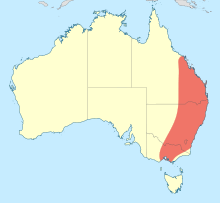Parasynthemis regina
Parasynthemis regina is a species of dragonfly in the family Synthemistidae,[4] known as the royal tigertail.[5] It is a medium to large and slender dragonfly with a long body and black and yellow markings.[5][6] It inhabits stagnant pools and swamps in eastern Australia[7]
| Royal tigertail | |
|---|---|
| Scientific classification | |
| Kingdom: | Animalia |
| Phylum: | Arthropoda |
| Class: | Insecta |
| Order: | Odonata |
| Infraorder: | Anisoptera |
| Family: | Synthemistidae |
| Genus: | Parasynthemis Carle, 1995[2] |
| Species: | P. regina |
| Binomial name | |
| Parasynthemis regina | |
 | |
| Synonyms[4] | |
| |
Parasynthemis regina is also known as Synthemis regina.[8]
Gallery
.jpg) Female wings
Female wings.jpg) Male wings
Male wings
gollark: <@!543131534685765673> That looks like *discussion* of him banning you.
gollark: It's more complicated → more problemer. You hear about a lot of issues with XML files including external entities and whatnot.
gollark: Which is probably unnecessary and results in security issues and bigger datas.
gollark: You can include some kind of JSON schema (because there are lots of things for that) with the docs. Though presumably someone will notice if the API is missing a field they need.
gollark: Your API should have documentation. Just use that.
See also
References
| Wikimedia Commons has media related to Parasynthemis regina. |
- Hawking, J. (2009). "Parasynthemis regina". IUCN Red List of Threatened Species. 2009: e.T163570A5617416. doi:10.2305/IUCN.UK.2009-2.RLTS.T163570A5617416.en.
- Carle, F.L. (1995). "Evolution, taxonomy, and biogeography of ancient Gondwanian libelluloides, with comments on anisopteroid evolution and phylogenetic systematics (Anisoptera: Libelluloidea)". Odonatologica. 24 (4): 383–424 [393] – via natuurtijdschriften.nl.
- Selys-Longchamps, E. (1874). "Additions au synopsis des Cordulines". Bulletin de la Classe des Science, Académie Royale de Belgique. 2 (in French). 37: 16–34 [31] – via Biodiversity Heritage Library.
- "Species Parasynthemis regina Selys, 1874". Australian Faunal Directory. Australian Biological Resources Study. 2012. Retrieved 6 March 2017.
- Theischinger, Günther; Hawking, John (2006). The Complete Field Guide to Dragonflies of Australia. Collingwood, Victoria, Australia: CSIRO Publishing. p. 202. ISBN 978 0 64309 073 6.
- Watson, J.A.L.; Theischinger, G.; Abbey, H.M. (1991). The Australian Dragonflies: A Guide to the Identification, Distributions and Habitats of Australian Odonata. Melbourne: CSIRO. p. 278. ISBN 0643051368.
- Theischinger, Gunther; Endersby, Ian (2009). Identification Guide to the Australian Odonata (PDF). Department of Environment, Climate Change and Water NSW. p. 232. ISBN 978 1 74232 475 3.
- Schorr, Martin; Paulson, Dennis. "World Odonata List". Slater Museum of Natural History. University of Puget Sound. Retrieved 6 March 2017.
This article is issued from Wikipedia. The text is licensed under Creative Commons - Attribution - Sharealike. Additional terms may apply for the media files.
